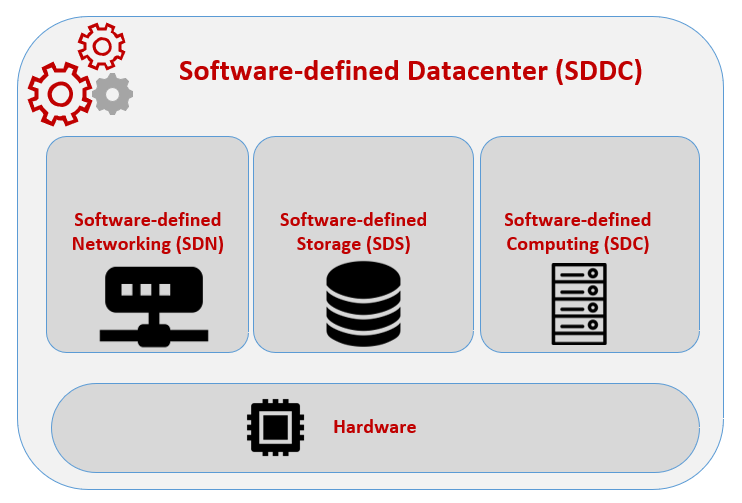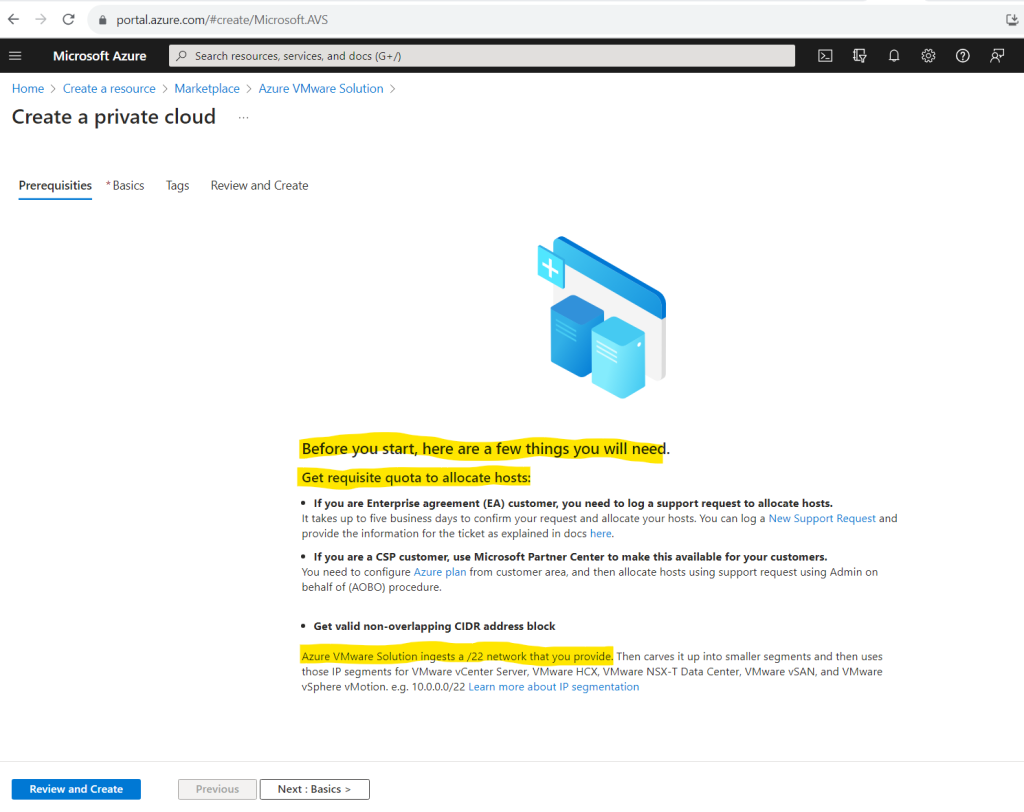Software Defined Data Center (SDDC) vs. Private Cloud
In this post I want to focus on the term Software Defined Data Center (SDDC) also called Virtual Data Center (VDC) and how it will differ from a private or public cloud.
To say it right away, the term Software Defined Data Center (SDDC) actually started as another marketing buzzword first mentioned in the year 2012 by VMWare to promote its own products with vCloudDirector and all its components plus Nicira/NSX.
In a nutshell already anticipated, a Software Defined Data Center (SDDC) architecture virtualizes and abstracts all of the underlying hardware resources like computing, networking and storage by using virtualized layers they already approved on the market with Software-defined computing (SDC), Software-defined networking (SDN) and Software-defined storage (SDS).
The cloud term, whether private cloud or public cloud is finally also nothing else than a marketing buzzword for provisioning computing services like servers, storage, databases, networking, software, etc. on demand for internal or external customers.
A Software Defined Data Center (SDDC) by contrast is the foundation and technology architecture behind through which cloud services (private or public) in the first place can be implemented and provisioned most efficiently.
So SDDCs also encompass private, public and hybrid clouds but doesn’t necessarily needs to be deployed just for this reason in your data center.
SDDCs in general will offer agility and can dramatically reduce the time to provision new resources in your data center, whether provisioned cloud-like (e.g. self-service support) or not. On top by using policy-driven automation in addition can further accelerate provisioning and enables you to deploy resources within minutes.
Finally dismissive spoken, Software Defined Data Center (SDDC) is just a new term for Infrastructure as a Service (IaaS). More precisely this is not entirely correct, Infrastructure-as-a-Service (IaaS) provisions computing, networking and storage functions to customers in form of a service and no need to run its own data center.
Software Defined Data Center (SDDC) in contrast allows you to run your own IaaS cloud platform in on-premises by virtualization of all hardware resources in the own data center.
Introduction
First I want to highlight the differences between a private and public cloud before we then will take a closer look about what in contrast a Software Defined Data Center (SDDC) exactly is.
The term cloud or cloud computing whether we speak about a public or private cloud refers in general to a computing infrastructure and environment which will provide computing services like servers, storage, databases, networking, software, etc.
Both cloud computing models major goal is to offer scalability, automation and self-service to scale the required infrastructure to the desired level.
Public Cloud
A public cloud in particular refers to a cloud computing model where computing resources, such as virtual machines, storage, and applications, are provided and managed by a third-party cloud service provider. These resources are made available to the general public or a large user base over the internet.
Private Cloud
A private cloud in contrast is dedicated to a single organization (single tenant) or entity providing computing infrastructure and environment just for their own users itself. The resources won’t be shared with other organizations and users.
Private clouds offer a higher level of security and privacy because they are not shared with other organizations. This isolation is particularly important for businesses that handle sensitive data or have strict regulatory compliance requirements.
Usual on-premises data centers are not the same as a private cloud, although they share some similarities like owning and managing the physical hardware, networking equipment, and infrastructure.
The key difference is that in a private cloud, the infrastructure is designed to provide cloud-like features, such as virtualization, self-service capabilities, and scalability. In a nutshell how the computing resources will be provided to the users.
On-premise data centers in contrast may use virtualization technologies to increase resource utilization and flexibility, but they may not necessarily provide the same level of self-service and automation as a private cloud.
What exactly is a Software-defined data center (SDDC)?
A Software Defined Data Center (SDDC) also called Virtual Data Center (VDC) virtualizes and abstracts all of the underlying hardware resources like computing, networking and storage.
In a traditional data center, the infrastructure (servers, storage, and networking) is typically managed and configured manually, often requiring significant time and effort. In contrast, an SDDC leverages software-defined technologies to abstract and automate the management of these infrastructure components.
SDDCs heavily rely on virtualization technologies to abstract and pool computing, storage, and networking resources. Virtualization allows for the creation of virtual machines (VMs), virtual networks, and virtual storage, decoupling the logical representation of resources from their physical counterparts.
SDDC combines the following approaches which are already approved on the market:
- SDN (Software Defined Network)
- SDS (Software Defined Storage)
- SDC (Software Defined Compute)
SDDC provides here a single software toolset to manage all those virtualized resources at a central place.

The goal of a Software Defined Data Center (SDDC) is to create a more agile, efficient, and cost-effective infrastructure that can adapt to the dynamic requirements of modern businesses.
As mentioned to the beginning, the term Software Defined Data Center (SDDC) was coined by the former CTO of VMWare, Dr. Steve Herrod at Interop 2012.
To summarize some of Steve’s comments – “Specialized software will replace specialized hardware throughout the data center… SDDs will redefine infrastructure for the next generation of applications… We need to move beyond VMs to virtualizing the rest of the data center, including storage, networking & security – this new container is the Virtual Data Center (VDC)… Organizations could operate virtual data centers in which all the infrastructure services are delivered as software and the control of the data center is entirely driven by software.”
While VMs can be provisioned in minutes, provisioning the rest of the data center (storage, networking, security, etc.) takes days – the SDD vision, with the VDC container holds the promise of bringing this down to minutes, unleashing a whole new level of agility in the data center.
Source: https://octo.vmware.com/the-software-defined-data-center-sdd-sdn-network-virtualization/
Benefits by using SDDCs
Implementing an SDDC architecture can offer both short- and long-term benefits. The primary short-term benefit is agility. With an SDDC, you can dramatically reduce the time to provision new resources. It no longer takes days or weeks to set up a new physical server, provide more storage capacity to an application or modify physical networking. Policy-driven automation can further accelerate provisioning, enabling you to deploy resources in minutes.
An SDDC can also help improve infrastructure performance. You can optimize compute, storage, and networking for each application and workload without having to undertake physical changes to the infrastructure.
In the long term, the SDDC helps control costs. Pooling resources improves utilization of infrastructure and enables you to avoid new infrastructure purchases. Better utilization also means that less infrastructure sits idle — consuming real estate, power, and cooling.
Source: https://www.ibm.com/topics/software-defined-data-center
SDDCs Solutions on the Market
There are several companies like VMWare, Microsoft, Dell, HPE, etc. which all offers some solutions more or less SDDC like.
Most of these solutions are so called Converged- and or Hyperconverged Infrastructure (HCI) solutions. Software-Defined Data Center (SDDC) and Hyperconverged Infrastructure (HCI) are both modern approaches to data center architecture, but they have distinct characteristics and serve different purposes.
SDDC (Software-Defined Data Center) is a holistic approach to data center management that virtualizes and abstracts the entire data center infrastructure, including compute, storage, and networking. It involves the use of software-defined technologies to automate and orchestrate various data center functions.
HCI (Hyperconverged Infrastructure) is a specific implementation within the broader scope of SDDC. It integrates compute, storage, and networking into a single, unified system.
HCI solutions typically use commodity hardware and a software layer to provide a tightly integrated and easily scalable infrastructure.
More about Converged- and or Hyperconverged Infrastructure (HCI) you will find in my following post.
VMware
VMware offers you several options for implementing the software-defined data center architecture in your private data center and beyond:
As a Private Cloud
VMware vCloud® Suite — Build and run your vSphere-based private cloud
Turn your data center into a vSphere-based private cloud using the software-defined datacenter architecture. Deliver the best SLAs for all applications through software-defined services, policy-based provisioning and automated operations management.
vCloud Suite
As a Hybrid Cloud
VMware vCloud® Hybrid Service™ — Your fastest route to a seamless hybrid cloud.
In just hours, extend your data center with a public Infrastructure-as-a-Service (IaaS) built on VMware’s software-defined data center technology, operated and supported by VMware and fully compatible with your data center environment.
vCloud Hybrid Service
Public cloud services from VMware partners — IT resources when you need them.
Robust, secure and flexible services delivered by our global ecosystem of certified VMware service providers:
vCloud Data Center Services
By integrating a private cloud with a public cloud built on software-defined data center technology, your data center becomes a true hybrid cloud platform, seamlessly spanning on-premises and off-premises environments with a common management, orchestration, networking and security model.
Learn More
See http://www.vmware.com/software-defined-datacenter for more information.
Azure VMware Solution
Azure VMware Solution provides a unified VMware Software-Defined Data Center (SDDC) in the Azure cloud integrating VMware vSphere®, VMware vSAN™, and VMware NSX® for compute, storage, and networking. Also included is the VMware HCX® workload mobility platform designed to simplify migrations to the cloud.
Azure VMware Solution provides private clouds that contain VMware vSphere clusters built from dedicated bare-metal Azure infrastructure.
Azure VMware Solution is available in Azure Commercial and Azure Government. The minimum initial deployment is three hosts, with the option to add more hosts, up to a maximum of 16 hosts per cluster. All provisioned private clouds have VMware vCenter Server, VMware vSAN, VMware vSphere, and VMware NSX-T Data Center. As a result, you can migrate workloads from your on-premises environments, deploy new virtual machines (VMs), and consume Azure services from your private clouds. For information about the SLA, see the Azure service-level agreements page.
Source: https://learn.microsoft.com/en-us/azure/azure-vmware/introduction


Microsoft
As shown above, Microsoft offers a Software-Defined Data Center (SDDC) solution through its Azure platform with Azure VMware Solution. But here Microsoft just contributes with the dedicated bare-metal Azure infrastructure, the software and virtualization stack comes finally from VMWare.
Microsoft also extends its SDDC capabilities to on-premises environments through offerings like Azure Stack Hub (formerly known as Azure Stack) or Azure Stack HCI.
But where Azure Stack Hub (formerly known as Azure Stack) is a cloud service which brings Azure services and capabilities to on-premises data centers, and Azure Stack HCI is as already implied with its name a Hyperconverged Infrastructure (HCI) dedicated single and unified system, both solutions are finally not really a native Software-Defined Data Center (SDDC) solution.
More about Azure Stack Hub and Azure Stack HCI I will post soon in a dedicated post.
Links
Introduction to the Software-Defined Data Center
https://developer.vmware.com/sddc-getting-startedWhat is Software-Defined Networking (SDN)?
https://www.vmware.com/topics/glossary/content/software-defined-networking.htmlThe Software-defined Data Center (SDD), SDN, Network Virtualization…
https://octo.vmware.com/the-software-defined-data-center-sdd-sdn-network-virtualization/The Future of the Data Center Is Software Defined
https://i.dell.com/sites/doccontent/shared-content/campaigns/en/Documents/Future_of_data_center.pdfSoftware-Defined Data Centers
https://www.ibm.com/topics/software-defined-data-center



